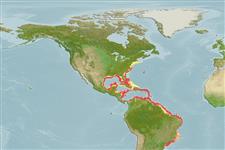Preferred temperature (Ref.
115969): 14.8 - 23.7, mean 19.5 (based on 93 cells).
Fylogenetische diversiteitsindex (Ref.
82804): PD
50 = 0.5001 [Uniqueness, from 0.5 = low to 2.0 = high].
Bayesian length-weight: a=0.01585 (0.01218 - 0.02063), b=3.04 (3.01 - 3.07), in cm Total Length, based on LWR estimates for this species (Ref.
93245).
Trofisch niveau (Ref.
69278): 4.0 ±0.58 se; based on food items.
Weerstandsvermogen (Ref.
120179): laag, minimale populatieverdubbelingstijd 4,5-14 jaar (K=0.07-0.09; tmax=27).
Fishing Vulnerability (Ref.
59153): High vulnerability (64 of 100).
Climate Vulnerability (Ref.
125649): Moderate to high vulnerability (51 of 100).
